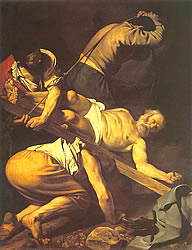2 Peter
 The Second Epistle of Peter, often referred to as Second Peter and written 2 Peter or in Roman numerals II Peter (especially in older references), is a book of the New Testament of the Bible, traditionally held to have been written by Apostle Peter. Most critical biblical scholars have concluded Peter is not the author, considering the epistle pseudepigraphical.
The Second Epistle of Peter, often referred to as Second Peter and written 2 Peter or in Roman numerals II Peter (especially in older references), is a book of the New Testament of the Bible, traditionally held to have been written by Apostle Peter. Most critical biblical scholars have concluded Peter is not the author, considering the epistle pseudepigraphical.
According to the Epistle itself, it was composed by the Apostle Peter, an eyewitness to Jesus' ministry. If 2 Peter 3:1 alludes to 1 Peter, the audience of the epistle is the various Churches in Asia Minor in general (cf. 1 Peter 1:1).
It criticizes "false teachers" who distort the authentic, apostolic tradition, and predicts judgment for them. 2 Peter explains that God is patient, and has not yet brought the Second Coming of Christ in order that more people will have the chance to reject evil and find salvation (3:3-9). It calls on Christians to wait patiently for the parousia and to study scripture.
The date of composition has proven to be very difficult to determine. Taken literally, it would have been written between 65-68 AD because Peter was martyred around 68 AD by Nero and also because Peter references his approaching death in 2 Peter 1:14 ("since I know that the putting off of my body will be soon, as our Lord Jesus Christ made clear to me").
Most biblical scholars have concluded Peter is not the author, considering the epistle pseudepigraphical. Reasons for this include its linguistic differences from 1 Peter, its apparent use of Jude, possible allusions to 2nd-century gnosticism, encouragement in the wake of a delayed parousia, and weak external support.
The questions of authorship and date are closely related. For Petrine authorship to be authentic, it must have been written prior to Peter's death in c. AD 65-67. The letter refers to the Pauline epistles and so must post-date at least some of them, regardless of authorship, thus a date before 60 is improbable. Further, it goes as far as to name the Pauline epistles as "scripture" - the only time a New Testament work refers to another New Testament work in this way - implying that it postdates them by some time. Scholars consider the epistle to be written anywhere between c. AD 60-130, with a favour for a date between 80-90 and so contend that it is pseudepigraphical.
In both content and style this letter is very different from 1 Peter. The epistle presciently declares that it is written shortly before the apostle's death (1:14). Arguments have been made both for and against this being part of the original text, but this debate largely is centered on the acceptance or rejection of supernatural intervention in the life of the writer.
The epistle contains eleven references to the Old Testament. In 3:15, 16 a reference is made to one of Paul's epistles, which some have identified as 1 Thessalonians 4:13-5:11.
The book also shares a number of passages with the Epistle of Jude, 1:5 with Jude 3; 1:12 with Jude 5; 2:1 with Jude 4; 2:4 with Jude 6; 2:5 with Jude 5; 2:6 with Jude 7; 2:10-11 with Jude 8-9; 2:12 with Jude 10; 2:13-17 with Jude 11-13; 2:18 with Jude 16; 3:2f with Jude 17f; 3:3 with Jude 18; 3:14 with Jude 24; and 3:18 with Jude 25. Because the Epistle of Jude is much shorter than 2 Peter, and due to various stylistic details, the scholarly consensus is that Jude was the source for the similar passages of 2 Peter.
Tartarus is mentioned in 2 Peter 2:4 as devoted to the holding of certain fallen angels. It is elaborated on in Jude 6. Jude 6 however, is a clear reference to the Book of Enoch. Bauckham suggests that 2 Peter 2:4 is partially dependent on Jude 6 but is independently drawing on paraenetic tradition that also lies behind Jude 5-7. The paraenetic traditions are in Sirach 16:7-10, Damascus Document 2:17-3:12, 3 Maccabees 2:4-7, Testament of Naphtali 3:4-5 and Mishna Sanhedrin 10:3.
View the Chapters of 2 Peter:
1
2
3